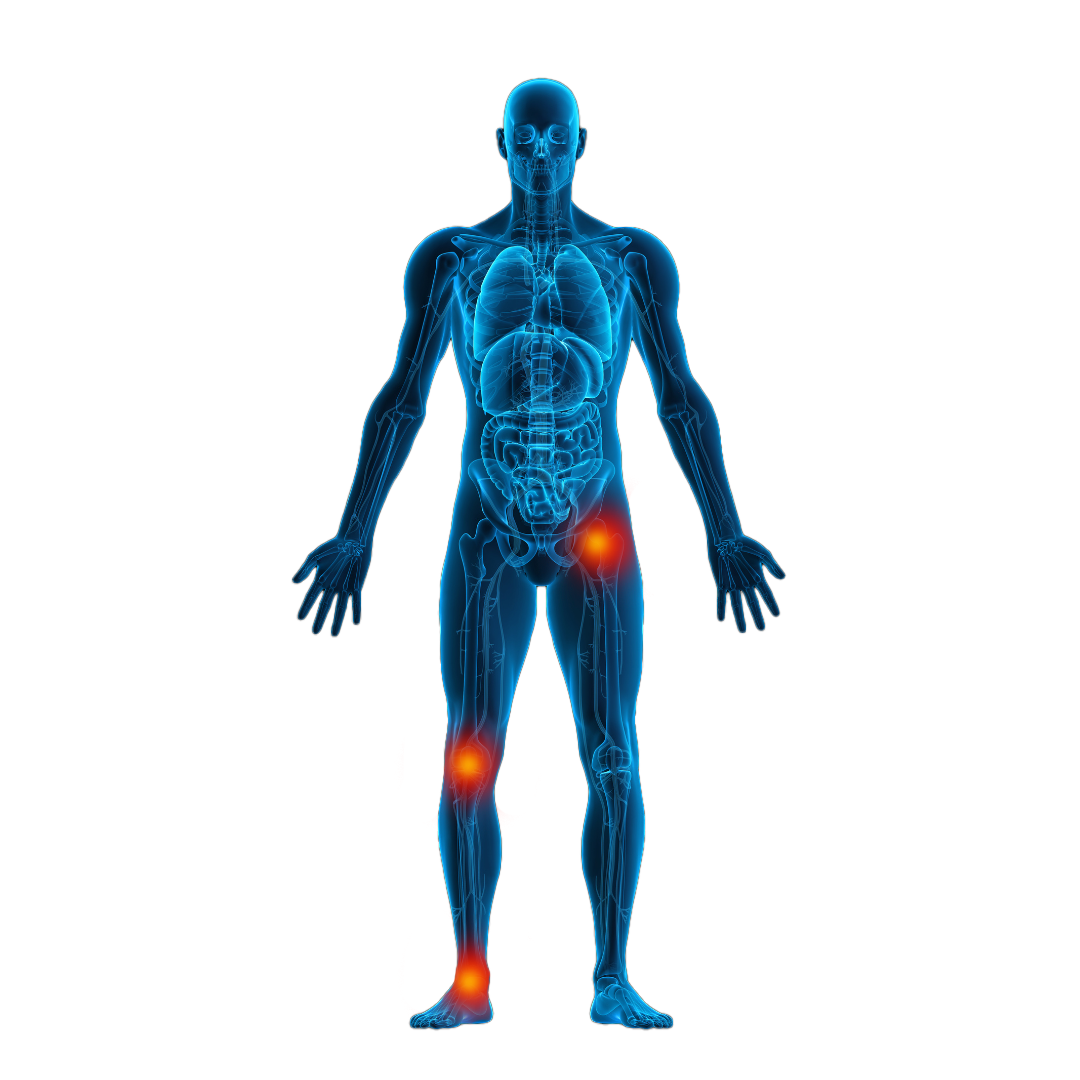Struggling with low back pain that limits your standing and walking? You’re not alone.
Your Answer to Back Pain Relief
If you’re struggling with low back pain, all hope is not lost. Many people find themselves slowing down or struggling to walk or stand comfortably due to pain. Physical Therapy is the number one recommendation from physicians to manage and fix low back pain.
Get Answers From a Virtual Physical Therapist
Understanding the Low Back
Low back pain can be debilitating, especially when it worsens with everyday tasks like standing and walking. This pain can originate from multiple areas within the lower back, including joints, discs, nerves, and soft tissues. By understanding where the pain is coming from, you can take the first step toward lasting relief through an effective treatment plan.

Vertebrae
The bones that make up the spine which provide structural support and protects the spinal cord.
Nerve
Bundles of fibers that transmit signals between the brain and the rest of the body.
Discs
Cushion-like pads between vertebrae that absorb shock and allow for flexibility in the spine.
Facets
The joints between vertebrae that enable movement and provide stability.
Foramina
Openings in the vertebrae through which nerves exit the spinal column, which can become narrowed, leading to nerve compression.
Stenosis
The narrowing of spinal canals or foramina often causes nerve compression, which can result in pain, numbness, or weakness.
Finding the Source
Disc Injuries
Often associated with herniations or bulges, and pain is commonly reported in the back, hip, leg and/or foot. Symptoms are often worse with sitting and bending and improve with standing and walking.
Stenosis, DDD
A slow, degenerative condition that is most common in people over 50. Symptoms can range from back pain to leg pain and are often better with sitting and bending and worse with standing and walking.
Facet Arthopathy
A degenerative condition that is localized to the joints of the spine. Patients often experience pain with walking, twisting, and tipping to one side.
Weakness & Stiffness
A precursor to the conditions above, where individuals are challenged with lifting and carrying objects, rolling in bed, and exercising.
Should You Get an MRI?

A common misconception is that you need an MRI before starting treatment. Physical Therapists are trained to diagnose and treat injuries without imaging. Through a thorough assessment, they can identify the underlying cause of your pain.
In fact, most insurance companies require patients to start with Physical Therapy first before authorizing an MRI. If your Physical Therapist determines that an MRI is necessary, they will work with your physician to get it authorized early.
Finding the Source
Disk Injuries
Often associated with herniations or bulges, and pain is commonly reported in the back, hip, leg and/or foot. Symptoms are often worse with sitting and bending and improve with standing and walking.
Stenosis, DDD
A slow, degenerative condition that is most common in people over 50. Symptoms can range from back pain to leg pain and are often better with sitting and bending and worse with standing and walking.
Facet Arthopathy
A degenerative condition that is localized to the joints of the spine. Patients often experience pain with walking, twisting, and tipping to one side.
Weakness & Stiffness
A precursor to the conditions above, where individuals are challenged with lifting and carrying objects, rolling in bed, and exercising.
Should You Get an MRI?
A common misconception is that you need an MRI before starting treatment. Physical Therapists are trained to diagnose and treat injuries without imaging. Through a thorough assessment, they can identify the underlying cause of your pain.

In fact, most insurance companies require patients to start with Physical Therapy first before authorizing an MRI. If your Physical Therapist determines that an MRI is necessary, they will work with your physician to get it authorized early.
Find the Underlying Cause
Managing, improving, and fixing back pain can be easier than you think. The most common reason the low back sustains an injury is because of compensation. When areas around the low back suffer from weakness or tightness, the low back compensates and inherits added stress. Over time, this stress can cause breakdown, pain, and injury.

Fix the
Compensations
While heat, ice, massage, and medications may provide temporary relief, the best long-term solution is to correct compensations that add stress to the lower back.
Compensation occurs when areas around the injured body part become overused or altered in an effort to maintain proper function. Eventually, this compensation turns into added stress, causing breakdown, pain, and injury.
Selective stretching and strengthening around the spine can help manage both new and old injuries alike.


Fix the Compensations
While heat, ice, massage, and medications may provide temporary relief, the best long-term solution is to correct compensations that add stress to the lower back.
Compensation occurs when areas around the injured body part become overused or altered in an effort to maintain proper function. Eventually, this compensation turns into added stress, causing breakdown, pain, and injury.
Selective stretching and strengthening around the spine can help manage both new and old injuries alike.
Finding Relief
Here are the most common areas to target with exercises:

Core Strength
Helps to stabilize and support the spine.

Glute Strength
Important for support and to accomplish daily tasks.

Leg Strength
Ensure you’re evenly balanced to support your low back.

Upper Back Mobility
Stiffness and poor posture can force the low back to move too much.

Ankle Mobility
Stiffness as far down as your ankle will ensure your back moves properly.

Hip & Leg Flexibility
Ensure you’re hips and legs are moving properly to protect your back.
Get Back on Track with a Conservative Approach
Our comprehensive low back program, Back in Balance, is designed to alleviate low back pain and improve your overall mobility and strength. Led by expert Physical Therapists, we’ll help you identify areas of need and provide you with a personalized exercise plan to get your life back.
No obligation, see if we can help
Get your questions answered

Don’t let low back pain from degenerative conditions hold you back. Our expert-designed program, Back in Balance gives you the tools and support you need to thrive. Join our community and start your journey to better back health today!
Frequently Asked Questions
What does the free consultation include?
The free consultation includes a comprehensive assessment of your condition by a certified Physical Therapist. Benefit from professional guidance to determine the best approach for your specific needs.
How do I schedule a free consultation?
Click on the “Schedule My Free Consult” button and fill out the form. Our team will contact you to arrange a convenient time for your consultation.
What kind of support is available if I need help?
We offer live one-on-one appointments with a certified Physical Therapist. Benefit from professional guidance and answers to your questions to help you make the most of your treatments.
What happens after the free consultation?
After the consultation, if you choose to proceed with treatment, you can either use your insurance or pay out-of-pocket. The first visit costs $99, and follow-up visits are $59 each. Insurance coverage and copays depend on your plan.
How are the visits conducted?
All visits are conducted virtually by certified Physical Therapists. Enjoy the convenience of accessing expert care from the comfort of your home.
Are there any obligations to continue after the free consultation?
No, there is no obligation to continue after the free consultation. It is risk-free and designed to help you understand your pain and potential solutions.
What types of exercises are included in your program?
Our program includes a personalized routine that includes stretching and strengthening exercises based on your immediate and unique needs.
What makes your program different from other pain management programs?
Our program is designed by certified Physical Therapists, ensuring that every exercise is safe, effective, and tailored to the unique needs of individuals with all types of low back conditions.
Take the First Step
Reclaim your strength and comfort with the support of expert guidance. Schedule a free online consultation with a Physical Therapist to see how our program can help you.

